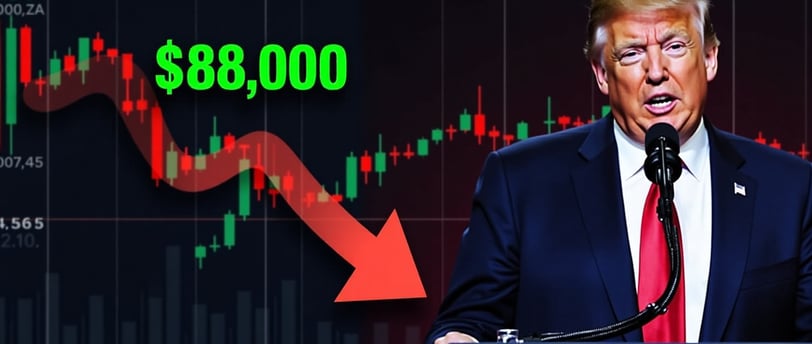Trump’s Tariff Announcement and Its Ripple Effects on the Crypto Market
The recent statements by Donald Trump regarding reciprocal tariffs have sent ripples through the financial world, particularly impacting the cryptocurrency market. Bitcoin, which had been trading near 88,000,droppedto84,000 following the announcement. While some expected these developments to stabilize or even boost markets, they instead triggered a wave of sell-offs. In this article, we’ll break down what happened, analyze the broader implications for the crypto market, and provide actionable strategies for investors navigating this volatile period.
4/2/20253 min read


Trump’s Tariff Announcement and Its Ripple Effects on the Crypto Market
The recent statements by Donald Trump regarding reciprocal tariffs have sent ripples through the financial world, particularly impacting the cryptocurrency market. Bitcoin, which had been trading near 88,000,droppedto84,000 following the announcement. While some expected these developments to stabilize or even boost markets, they instead triggered a wave of sell-offs. In this article, we’ll break down what happened, analyze the broader implications for the crypto market, and provide actionable strategies for investors navigating this volatile period.
What Happened? The Tariff Announcement Explained
Bitcoin’s Reaction to Trump’s Statements
Bitcoin initially surged to 88,000,buoyedbyoptimismsurroundingpotentialeconomicshifts.However,afterTrump’sannouncementaboutimposingtariffsonimportsfromcountrieslikeMexicoandCanada,thepricedippedto84,000. This decline reflects investor concerns about inflation, supply chain disruptions, and the overall uncertainty surrounding global trade policies.
Understanding Reciprocal Tariffs
Trump’s proposed tariffs involve imposing duties on goods such as steel and aluminum, with rates reaching up to 25%. These tariffs are designed to “reciprocate” the higher rates imposed by other nations, such as China, which currently levies tariffs as high as 67% on certain products. While Trump’s rates are lower than those of some countries, the sudden increase from previous levels has spooked markets.
The Impact of Tariffs on the Economy and Crypto Markets
Inflation Concerns: Cost vs. Monetary Inflation
One of the key fears stemming from these tariffs is their potential to drive inflation. However, it’s essential to distinguish between cost inflation and monetary inflation :
Cost Inflation: Occurs when prices rise due to increased production costs (e.g., higher tariffs on raw materials). For example, if a coxinha (a popular Brazilian snack) costs 1intheU.S.,atariff−inducedpricehiketo1.20 doesn’t mean the government printed more money—it simply reflects increased costs.
Monetary Inflation: Results from central banks printing excessive amounts of money, leading to widespread price increases.
While cost inflation may occur, monetary inflation isn’t directly tied to these tariffs. Analysts estimate that a 25% tariff on steel and aluminum could raise inflation by just 0.28% and reduce GDP growth by 0.53% , far less severe than many feared.
Supply Chain Disruptions and Economic Slowdown
Tariffs can disrupt global supply chains, increasing costs for manufacturers and consumers alike. Industries like automotive, construction, and technology—reliant on imported steel and aluminum—may face rising expenses. A slower economy could lead to reduced consumer spending, indirectly affecting sectors tied to cryptocurrencies, such as retail payments and decentralized finance (DeFi).
Uncertainty Reigns: Lessons from Past Crises
The current climate echoes earlier periods of market turmoil:
Dot-com Bubble (2002): Speculative investments collapsed under uncertainty.
Subprime Mortgage Crisis (2008): Overleveraged financial systems crumbled.
COVID-19 Pandemic (2020): Global lockdowns caused unprecedented volatility.
Today, Trump’s tariff announcements add another layer of uncertainty. The possibility of new tariffs being introduced in April creates an unpredictable environment, making investors jittery.
Federal Reserve’s Role Amid Rising Uncertainty
As economic uncertainty grows, all eyes turn to the Federal Reserve. If GDP growth slows further, the Fed may consider cutting interest rates to stimulate the economy. Lower interest rates often benefit risk assets like cryptocurrencies by reducing borrowing costs and encouraging investment. However, the Fed’s decisions will depend heavily on upcoming economic data, leaving markets in limbo for now.
Strategies for Crypto Investors: Navigating Volatility
Given the turbulence sparked by Trump’s tariff announcements, here are some strategies to help you navigate the crypto market effectively:
1. Stay Educated
Keep up with the latest news on trade policies, economic indicators, and Federal Reserve actions. Understanding macroeconomic trends allows you to anticipate market movements.
2. Diversify Your Portfolio
Avoid putting all your eggs in one basket. Spread your investments across different cryptocurrencies and asset classes, such as stocks, bonds, or commodities. Diversification helps mitigate risk during uncertain times.
3. Set Clear Exit Strategies
Before entering any trade, define your profit targets and stop-loss levels. This disciplined approach prevents emotional decision-making during market swings.
4. Exercise Patience
Crypto markets are inherently volatile, and short-term fluctuations shouldn’t dictate your long-term strategy. Stick to your plan and avoid panic-selling during downturns.
Want expert guidance on building a resilient crypto portfolio? Download our free guide on ecofin360.com and start investing smarter today.
Looking Ahead: What’s Next for the Market?
While the immediate reaction to Trump’s tariffs was negative, there’s potential for stabilization in the medium to long term. Possible outcomes include:
Trade Negotiations: Countries may negotiate lower tariffs, easing market tensions.
Economic Adjustments: Businesses might adapt to higher costs, minimizing long-term impacts.
Fed Interventions: Interest rate cuts could inject liquidity into the economy, benefiting risk assets like Bitcoin.
For now, the market remains cautious, awaiting clearer signals about future trade policies and their effects on inflation and growth.
Conclusion: Preparing for a New Market Reality
Trump’s tariff announcements have introduced a fresh wave of uncertainty into the crypto market. While the immediate impact has been challenging, history shows us that markets eventually adapt and find equilibrium. By staying informed, diversifying your investments, and maintaining a disciplined approach, you can position yourself to thrive despite short-term volatility.
Ready to stay ahead of the curve? Subscribe to our newsletter for weekly updates on market trends, policy changes, and actionable crypto insights. Together, we’ll navigate the complexities of the ever-evolving crypto landscape.
SEO Keywords: Trump tariffs crypto, Bitcoin market impact, Federal Reserve crypto policy, inflation and crypto, cryptocurrency investment strategies, trade tariffs and crypto volatility.
